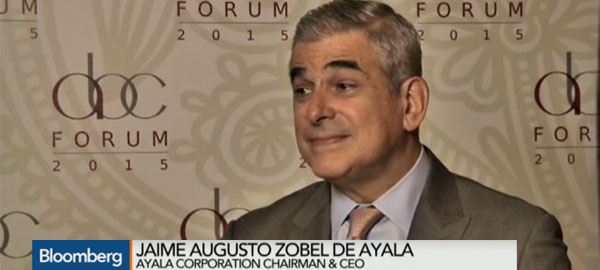After years of slump, the Philippines is now one of the fastest growing countries in Asia. Multinational and local corporations are benefiting from strong macroeconomics and large untapped market to seize growth opportunities. Jaime Augusto Zobel de Ayala shares his views on opportunities and challenges of the Philippines.
Jaime Augusto Zobel de Ayala is the CEO of Ayala Corporation, one of the largest and oldest conglomerates in the Philippines. He is interviewed by Bloomberg’s Haslinda Amin on the side of the ASEAN Business Club forum.
Economic strengths of the Philippines
After being labeled “the sick man of Asia” for years, the Philippines is now on a phenomenal trend of economic growth, especially showing a 60% growth in Foreign Direct Investments in 2014 and a 8% GDP growth projected for 2015.
Some elements demonstrate that the Philippine growth is structured on a strong fundamental consumer demand and that it can therefore be sustainable:
- internal consumer demand is fairly high
- the large community of overseas Filipinos regularly send money remittances back home in a growing year-to-year trend
- these two parts of the population make up a strong middle class both inside and outside the country
Aside from consumer demand, Business Process Outsourcing – BPO – is a leading industry in the Philippines; it drains a lot of foreign capital into the Philippines.
Challenges of the Philippine economy
Besides these positive signs, the Philippines still faces several challenges to be tackled promptly in order to ensure the country’s growth is sustainable. Despite the growth of Foreign Direct Investment – FDI –, the Philippines is still lagging behind several Asian countries in terms of FDI.
FDI especially need to be invested into infrastructure. Infrastructure expenditures now represent about 2% of the Philippines’s GDP, while they would need to move up to 5% of GDP in order to remove the infrastructure bottlenecks that constrain the country’s economic growth.
The Philippine government is however taking positive steps to ensure the incoming of foreign capital to develop infrastructures, with a Public-Private Partnership – PPP – structure being implemented. The stable macroeconomic environment is also helping incoming capital with low interest rates and stable foreign exchanges.
Business opportunities in the Philippines
The Philippines still has a large part of its population of a 100 million people that do not use banking services. Various solutions to tap into this market are being implemented; Ayala is combining its telecom and banking businesses to reach these “unbanked” consumers. They are creating a micro-finance bank, reaching communities via technology and implementing on-air payments.
Infrastructures need to be developed on several fronts: ports, rail, roads, airports… Some Philippine private corporations now have enough resources to tackle some of these large projects: Ayala is investing in rail and toll roads infrastructures. Thanks to the support of the government, the Philippines do not need to rely solely on foreign MNC for such large infrastructure projects anymore.
The removal of infrastructural bottlenecks will provide a substantial relief to the Philippine economy, particularly helping Greater Metro Manila to implement its sustainable development plan in the coming years. This movement should spread to other areas and industries, as national capital is being redeployed together with FDIs.
Bloomberg video from May 2015









